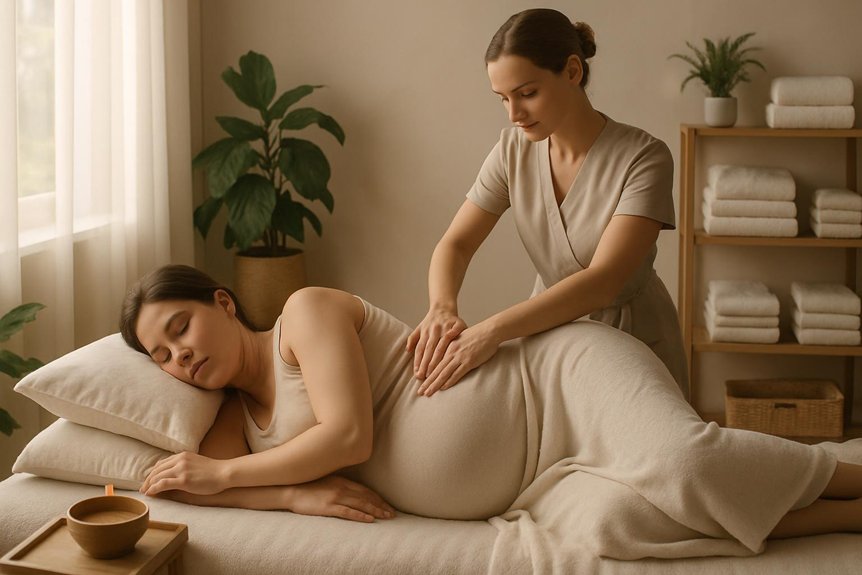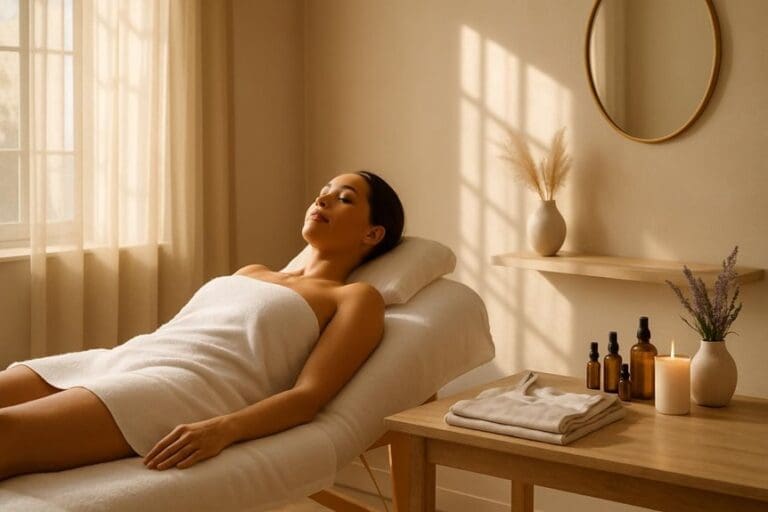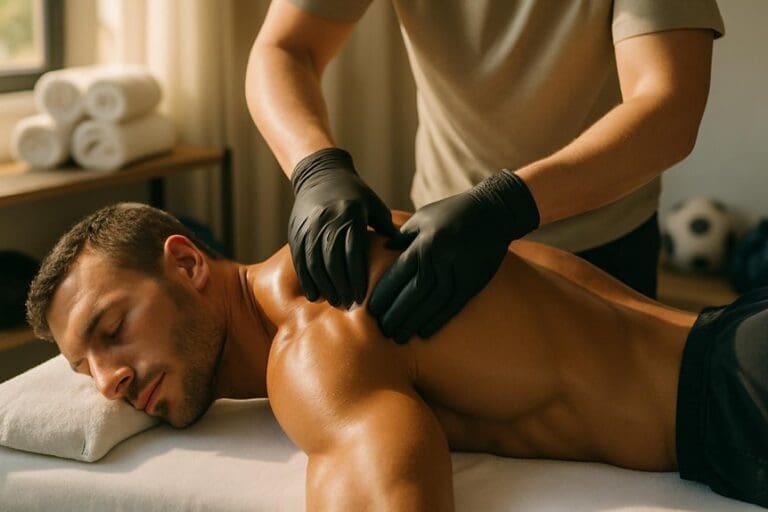When performed by a therapist with specialised prenatal training, prenatal massage is generally safe for most expectant mothers, provided contraindications are identified and proper techniques are employed. It requires trimester-specific adjustments, careful positioning to prevent vascular compression, and avoidance of deep or vigorous manipulation, especially in high-risk cases. A thorough clinical assessment and consultation with healthcare providers are essential. For those interested in understanding clinical guidelines, contraindications, and best practices for prenatal massage, further details are provided below.
Understanding Maternity Massage
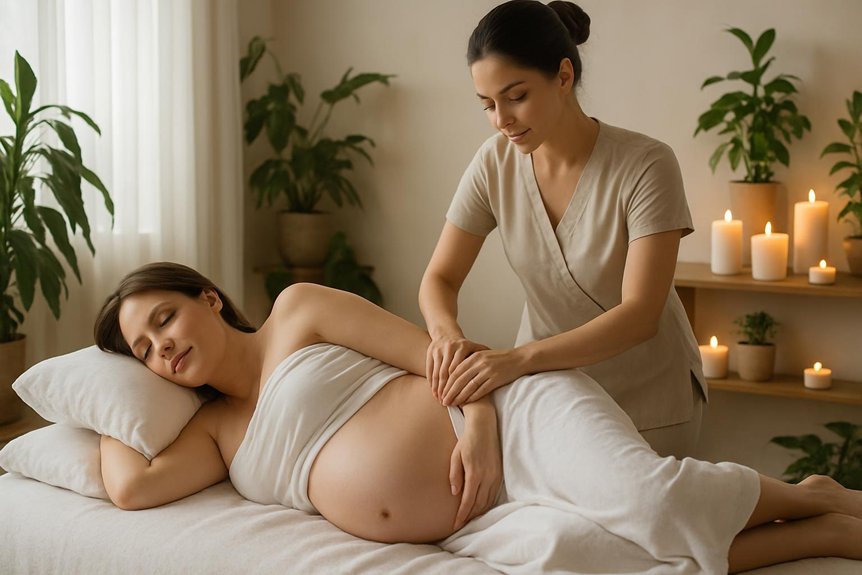
Although pregnancy is a natural physiological process, it introduces significant anatomical and hormonal changes that can influence musculoskeletal health and overall wellbeing.
Pregnancy massage is a specialised manual therapy designed to address these evolving needs. By utilising techniques tailored to the gravid body, therapists aim to alleviate common discomforts such as lumbar pain, pelvic tension, and oedema.
Evidence indicates that properly delivered maternity massage may reduce stress hormones and promote circulatory efficiency, supporting both maternal and fetal health.
In Spa & Massage clinics, expertly trained therapists employ safe positioning and gentle, targeted pressure to mitigate risk and optimise comfort.
The approach is always individualised, respecting contraindications and adapting to each stage of gestation.
As highlighted in recent research, the benefits of prenatal massage can provide significant relief for expecting mothers, improving their overall sense of wellbeing during pregnancy.
Ultimately, understanding these principles is essential for delivering safe and effective care.
Safety Considerations During Each Trimester
Massage therapists at Spa & Massage recognize that pregnancy introduces trimester-specific safety considerations, requiring tailored precautions in both technique and positioning.
During the first trimester, particular attention is given to minimizing pressure and avoiding certain trigger points due to increased miscarriage risk.
As pregnancy progresses, later stages necessitate adjustments such as side-lying positioning and modified pressure to accommodate physiological changes and reduce risks like supine hypotensive syndrome.
First Trimester Precautions
During the first trimester of pregnancy, heightened physiological changes and increased vulnerability necessitate careful consideration of any therapeutic intervention, including massage. Clinical evidence suggests that this stage is associated with higher miscarriage risk and fluctuating hormone levels, which may influence maternal response to external stimuli.
At Spa & Massage, therapists exercise particular caution, often recommending that clients consult with their healthcare provider before booking a session in early pregnancy.
When prenatal massage is performed, practitioners avoid deep abdominal work, strong pressure, or the use of certain aromatherapy oils that may not be suitable in early gestation.
Gentle, nurturing techniques are prioritised, focusing on relaxation and stress reduction. This careful, personalised approach honours the unique needs and sensitivities present during the first trimester.
Later Stage Adjustments
As gestation progresses into the second and third trimesters, evolving anatomical and physiological changes necessitate specific modifications to massage protocols to guarantee maternal and fetal safety.
Uterine growth increases lumbar lordosis and alters the center of gravity, requiring side-lying or semi-reclined positioning to prevent vena cava compression and enhance maternal comfort.
In Spa & Massage clinics, therapists avoid deep abdominal pressure and utilize gentle, supportive bolstering techniques to minimize musculoskeletal strain and promote relaxation.
Increased joint laxity, due to hormonal changes, also warrants a cautious approach to stretching and mobilization.
Therapists monitor for signs of edema or thromboembolic risk, maintaining open communication and adapting techniques accordingly.
These adjustments, rooted in clinical best practice, foster both physical wellbeing and a sense of nurturing intimacy throughout pregnancy.
Benefits of Maternity Massage for Expectant Mothers
Although pregnancy introduces complex physiological changes, targeted massage therapy has been shown to provide significant benefits for expectant mothers. Clinical evidence suggests that maternity massage can reduce musculoskeletal discomfort such as lower back pain, leg cramps, and sacroiliac joint tension, which are prevalent during gestation.
Therapeutic touch, when administered by qualified therapists such as those at Spa & Massage, may also modulate maternal stress hormones, promoting a sense of relaxation and improved sleep quality.
Technique adaptations—such as side-lying positioning and use of hypoallergenic oils—enhance safety and comfort. Regular sessions often foster a deeper sense of bodily awareness and emotional connection, addressing the unique vulnerabilities of this period.
Individual assessment remains vital to guarantee each treatment supports both maternal and fetal well-being.
Contraindications and When to Avoid this Massage
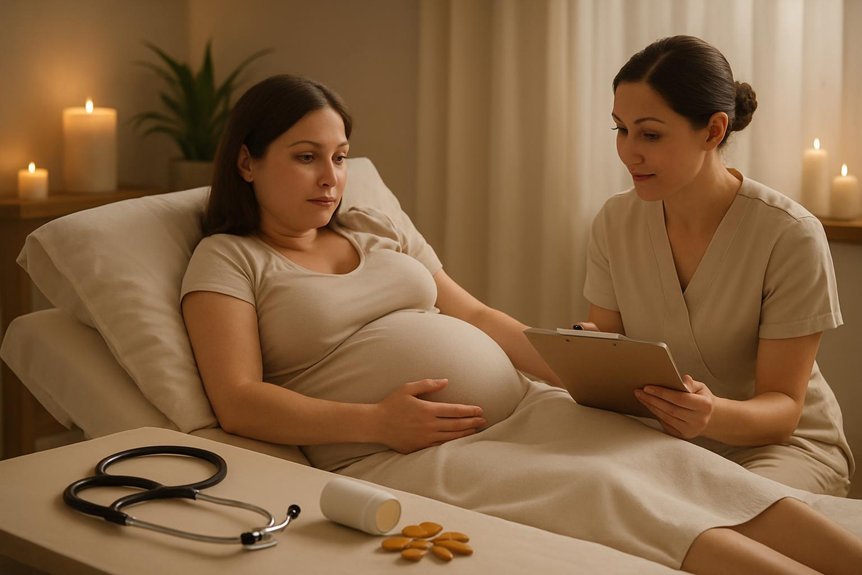
There are specific clinical scenarios in which prenatal massage is contraindicated due to increased risk, including high-risk pregnancy factors such as preeclampsia, placental abnormalities, or preterm labor history.
Certain medical conditions, including uncontrolled hypertension, deep vein thrombosis, or severe edema, also necessitate caution and may preclude treatment.
At Spa & Massage, a thorough consultation and collaboration with healthcare providers are standard practice to guarantee client safety.
High-Risk Pregnancy Factors
While maternity massage offers significant benefits for many expectant mothers, certain high-risk factors necessitate caution or complete avoidance of this therapy. Clinical guidelines advise against massage in cases of placenta previa, active preeclampsia, preterm labor risk, or unexplained vaginal bleeding.
These conditions may increase susceptibility to complications where massage could exacerbate underlying instability. At Spa & Massage, therapists conduct thorough consultations to identify any high-risk pregnancy factors before initiating treatment, always prioritising client safety.
When contraindications are present, professional guidance is essential before proceeding. By recognising these risks, the therapeutic environment remains nurturing and secure.
Expectant mothers experiencing high-risk factors are encouraged to communicate openly about their pregnancy status and medical history, ensuring all care decisions are made in partnership with medical professionals.
Medical Conditions Requiring Caution
Beyond high-risk pregnancy factors, certain medical conditions also require careful evaluation before proceeding with maternity massage. Pre-eclampsia, deep vein thrombosis (DVT), uncontrolled hypertension, placental abnormalities, and recent bleeding episodes are among the primary contraindications. These conditions increase the risk of complications, such as thromboembolism or impaired placental function, making massage inadvisable without explicit medical clearance.
At Spa & Massage, therapists are trained to screen for these risks and consult collaboratively with clients and, when necessary, their healthcare providers. Even with less acute concerns—such as gestational diabetes or severe varicose veins—modifications or physician approval may be necessary to ensure the mother’s and baby’s safety.
Prioritising open communication and meticulous assessment, Spa & Massage creates a supportive environment tailored to each individual’s clinical profile.
Qualified Therapists and Specialised Training
Because pregnancy presents unique physiological changes and potential risks, only therapists with specialised training and recognised qualifications should administer maternity massage.
At Spa & Massage, therapists undergo rigorous education in maternal anatomy, contraindications, and safe adaptations for each trimester. This expertise allows for the identification of warning signs such as deep vein thrombosis or preterm labour, ensuring early referral to medical care if necessary.
Clinical guidelines recommend that practitioners demonstrate proficiency in risk assessment and communication, which is fundamental for fostering trust and emotional comfort.
Clients benefit from knowing their therapist is equipped to navigate the complex interplay of hormonal, circulatory, and musculoskeletal changes. Such assurance supports not only physical relaxation but also peace of mind—essential for nurturing well-being during this intimate life stage.
Techniques and Positions Used for Comfort and Safety
In prenatal massage, meticulous attention to positioning and technique is paramount to minimise physiological risks and maximise maternal comfort. At Spa & Massage, therapists employ side-lying and semi-reclined positions, which reduce uterine pressure on major blood vessels and support ideal venous return.
Bolsters and pillows are strategically placed to alleviate musculoskeletal strain, particularly in the lower back, hips, and legs. Gentle, rhythmic strokes are favoured to promote circulation and lymphatic drainage without overstimulating soft tissues or joints.
Deep tissue manipulation is avoided in areas prone to oedema or vascular changes. Regular monitoring of maternal feedback ensures ongoing safety and a tailored experience.
This careful, responsive approach fosters a nurturing environment, addressing both physical and emotional needs throughout each stage of pregnancy.
Massage Oils and Products Suitable for Pregnancy
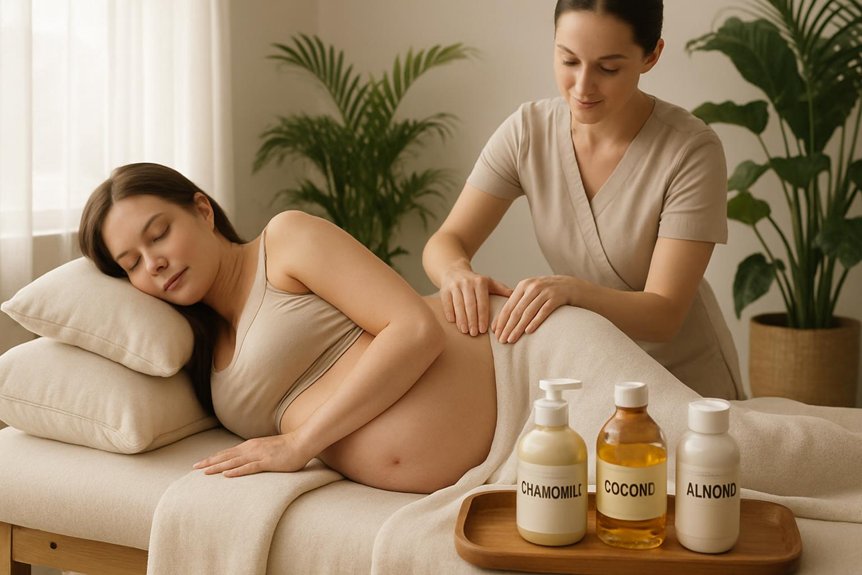
Alongside careful positioning and gentle techniques, the selection of massage oils and topical products directly impacts safety during prenatal massage.
Spa & Massage therapists adhere to evidence-based protocols, opting for hypoallergenic, unscented oils with minimal additives to reduce the risk of dermal sensitisation and allergic reactions.
Essential oils—particularly those not clinically established as safe in pregnancy, such as clary sage or rosemary—are strictly avoided due to potential uterotonic or sensitising effects.
Natural carrier oils, including sweet almond and grapeseed, are preferred for their emollient properties and low irritant profile.
Therapists at Spa & Massage conduct thorough consultations to identify individual sensitivities, ensuring product compatibility and maternal comfort.
This vigilance fosters a nurturing environment, respecting both physiological changes and the intimate nature of prenatal care.
Communication and Customisation of Treatment
How can safe and effective maternity massage be achieved without robust client-therapist communication?
At Spa & Massage, clinical evidence underscores the necessity of thorough pre-treatment consultation. This process involves eliciting detailed obstetric history, identifying any contraindications, and discussing client-specific symptoms or discomforts.
Open dialogue enables therapists to select appropriate techniques and adapt positioning to reduce risk, such as left lateral recumbency to avoid vena cava compression.
Customisation extends to pressure modulation and the use of hypoallergenic oils, always aligned with trimester-specific considerations.
By prioritising transparency and tailored care, therapists foster trust and intimacy, ensuring each session aligns with evolving maternal needs.
Ongoing communication throughout treatment further mitigates risk, empowering clients to voice concerns and adjust interventions for optimal safety and comfort.
Aftercare Recommendations for Pregnant Clients
Following a prenatal massage session, structured aftercare protocols are essential to minimise adverse events and optimise maternal well-being. At Spa & Massage, therapists advise clients to hydrate adequately post-treatment, as enhanced circulation and lymphatic drainage may increase fluid turnover.
Gentle mobility and rest are encouraged to prevent orthostatic hypotension, particularly after prolonged periods in a side-lying position. Any unusual symptoms—such as dizziness, persistent abdominal discomfort, or swelling—should be promptly reported to a healthcare provider.
Clients are counselled to avoid strenuous activities immediately following massage, allowing the body to integrate therapeutic effects. In our clinics, therapists provide personalised guidance, ensuring aftercare aligns with each client’s trimester and health status.
This attentive approach supports both physical safety and emotional reassurance during pregnancy’s unique journey.
Conclusion
In essence, prenatal massage—when administered by a qualified therapist using evidence-based protocols—can be a safe and beneficial adjunct to prenatal care. Like a steady hand guiding a vessel through shifting tides, clinical caution and customised techniques help navigate the changing landscape of pregnancy. By adhering to established contraindications, employing appropriate positioning, and using safe products, expectant mothers can minimise risk and maximise comfort, supporting maternal well-being throughout each trimester under the guidance of experienced professionals.
